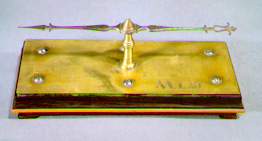
6.2 x 7 x 16.4
Steel, brass, bronze and wood
INDEX 1788 : M.I.51
Versoria duo chalybea long. poll. 6. et Bases binae rectangulae ligneae: ambae teguntur lamina ex orichalco, cui ferruminatus est stylus aeneus cum cuspide chalybea perpolita.
Two six inch long steel needles and two rectangular wooden bases covered with a brass plate to which is fixed a bronze spike with a highly polished steel tip.
In his studies on magnetism, Coulomb proposed a theory on the origin of the phenomenon. In his model he admitted, as Dufay did for electricity, the existence of two imponderable fluids which he called magnetic fluids. These fluids, distributed evenly on a magnetic needle, gave rise to the negative and positive poles. The fluids were different in nature from the electric fluids but they were able to act on one another. Like ones repelled and opposite ones attracted. Coulomb's model held that magnetic fluids could not exist in isolation nor manifest themselves in the absence of ponderable material.
In spite of certain similarities in the behaviour of electrically charged bodies and magnetic needles, in terms of the force of attraction or repulsion of the respective fluids, they were believed to be quite distinct. This was because the electric fluid could leave the body where it was first found, leaving it without charge, whereas it seemed that the magnetic fluid could not do this. In addition, even though an electrically charged body had one single kind of fluid, this was not the case with a body possessing magnetic fluid; in a magnetic needle, each of the fluids was always present at an extremity.
As Coulomb noted, if we bring a piece of iron close to a magnet, it acquires magnetic properties and can attract a second piece of iron. But if we then take these pieces of iron away from the magnet's influence, it can be seen that none of the magnetic fluid has passed from the magnet to the iron, nor from one piece of iron to the other. If the iron were touched by an electrically charged body then it too would possess the same sort of electric fluid. This difference in behaviour of magnetic and electric fluids led to the belief that the two were independent. For Coulomb, the magnetic fluids could only undergo extremely tiny displacement and were unable to leave the "molecule" of the magnetised body to which it belonged before magnetisation. In this way Coulomb rejected any possibility of interaction between electricity and magnetism.
The Museum has one of the two original needles, borne on a vertical spike fixed in a base. The steel needle is beautifully designed and worked; the base is a wooden parallelepiped with a brass plate covering its upper surface. As regards the other needle, only the base remains, and it is exactly the same as the other. The needle on it is a faithful copy of the other and, according to Rómulo de Carvalho, was beautifully executed in 1964 by Francisco Correia Galvão Júnior, the laboratory technician in the Physics Department of the Faculty of Science, University of Coimbra, at the time.
The set was used in the lessons relating to the chapter that dalla Bella called De Magnete.
From Colégio dos Nobres, catalogue n.º 47.